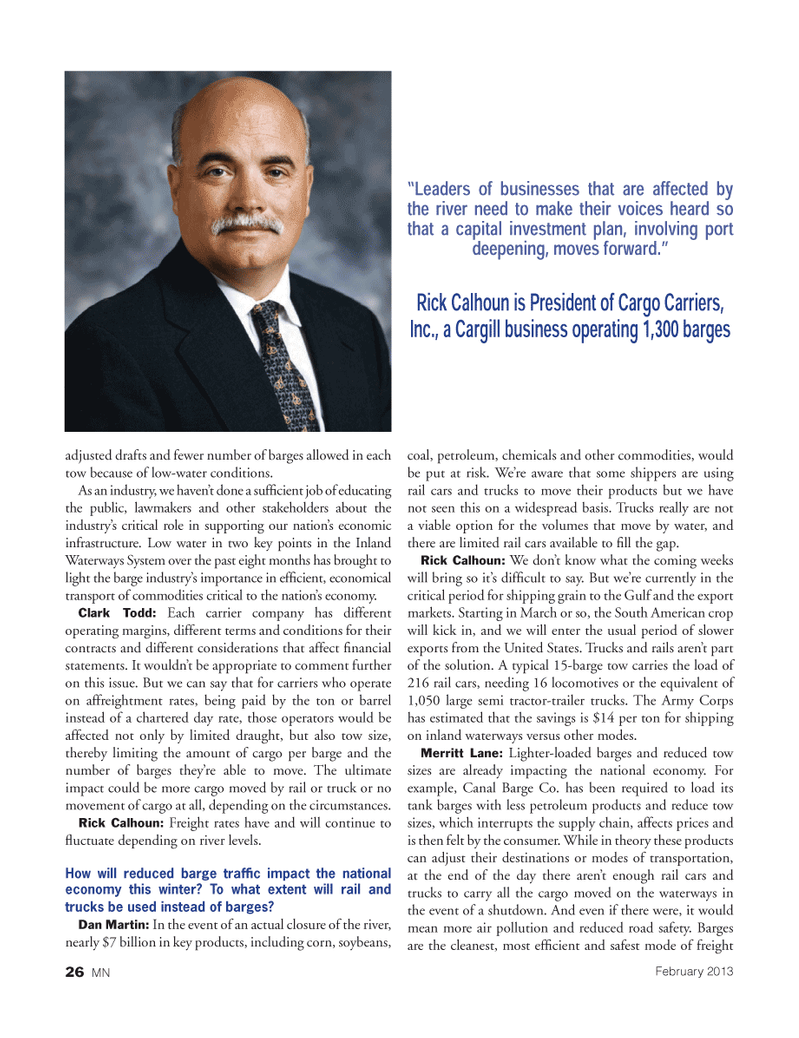
Page 26: of Marine News Magazine (February 2013)
Bulk Transport Leadership Roundtable
Read this page in Pdf, Flash or Html5 edition of February 2013 Marine News Magazine
adjusted drafts and fewer number of barges allowed in each tow because of low-water conditions. As an industry, we haven?t done a suf cient job of educating the public, lawmakers and other stakeholders about the industry?s critical role in supporting our nation?s economic infrastructure. Low water in two key points in the Inland Waterways System over the past eight months has brought to light the barge industry?s importance in ef cient, economical transport of commodities critical to the nation?s economy. Clark Todd: Each carrier company has different operating margins, different terms and conditions for their contracts and different considerations that affect nancial statements. It wouldn?t be appropriate to comment further on this issue. But we can say that for carriers who operate on affreightment rates, being paid by the ton or barrel instead of a chartered day rate, those operators would be affected not only by limited draught, but also tow size, thereby limiting the amount of cargo per barge and the number of barges they?re able to move. The ultimate impact could be more cargo moved by rail or truck or no movement of cargo at all, depending on the circumstances. Rick Calhoun: Freight rates have and will continue to uctuate depending on river levels. How will reduced barge trafÞ c impact the national economy this winter? To what extent will rail and trucks be used instead of barges? Dan Martin: In the event of an actual closure of the river, nearly $7 billion in key products, including corn, soybeans, coal, petroleum, chemicals and other commodities, would be put at risk. We?re aware that some shippers are using rail cars and trucks to move their products but we have not seen this on a widespread basis. Trucks really are not a viable option for the volumes that move by water, and there are limited rail cars available to ll the gap. Rick Calhoun: We don?t know what the coming weeks will bring so it?s dif cult to say. But we?re currently in the critical period for shipping grain to the Gulf and the export markets. Starting in March or so, the South American crop will kick in, and we will enter the usual period of slower exports from the United States. Trucks and rails aren?t part of the solution. A typical 15-barge tow carries the load of 216 rail cars, needing 16 locomotives or the equivalent of 1,050 large semi tractor-trailer trucks. The Army Corps has estimated that the savings is $14 per ton for shipping on inland waterways versus other modes. Merritt Lane: Lighter-loaded barges and reduced tow sizes are already impacting the national economy. For example, Canal Barge Co. has been required to load its tank barges with less petroleum products and reduce tow sizes, which interrupts the supply chain, affects prices and is then felt by the consumer. While in theory these products can adjust their destinations or modes of transportation, at the end of the day there aren?t enough rail cars and trucks to carry all the cargo moved on the waterways in the event of a shutdown. And even if there were, it would mean more air pollution and reduced road safety. Barges are the cleanest, most ef cient and safest mode of freight ?Leaders of businesses that are affected by the river need to make their voices heard so that a capital investment plan, involving port deepening, moves forward.?Rick Calhoun is President of Cargo Carriers, Inc., a Cargill business operating 1,300 barges26 MNFebruary 2013 MN Feb2013 Layout 18-31.indd 26MN Feb2013 Layout 18-31.indd 261/30/2013 4:49:21 PM1/30/2013 4:49:21 PM

 25
25

 27
27
